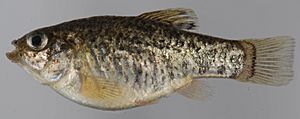Sheepshead minnow facts for kids
Quick facts for kids Sheepshead minnow |
|
|---|---|
 |
|
| Conservation status | |
| Scientific classification | |
| Subspecies | |
|
|
| Synonyms | |
|
The sheepshead minnow or sheepshead pupfish (Cyprinodon variegatus) is a small, tough fish. It is a type of ray-finned fish from the family called Cyprinodontidae, also known as pupfishes. You can find these fish living in salt marshes and estuaries, which are places where fresh water mixes with salty ocean water. They are native to the eastern coasts of North and Central America.
Contents
What Does the Sheepshead Minnow Look Like?
The sheepshead minnow has a deep body. It can grow up to 75 mm (about 3 inches) long, but usually it's around 30 mm (about 1 inch). Its body is almost half as deep as it is long, not counting its tail. It has flat sides and a curved back. Its head is small with a flat top.
The fish has a small mouth at the end of its snout. Its teeth are large and shaped like wedges, with three points on each tooth. The fins on its chest (pectoral fins) are big. The fin on its back (dorsal fin) is dark. Its other fins, like the ones on its belly (pelvic) and under its tail (anal), are orange. The tail fin is square-shaped.
Large, round scales cover its body. The scales on its cheeks and head are the biggest. Male sheepshead minnows are usually bigger and have deeper bodies than females. Their dorsal, pelvic, and anal fins are also larger.
Colors of the Sheepshead Minnow
Sheepshead minnows are olive green on top and yellowish underneath. Young fish have dark stripes across their bodies. Female fish keep these stripes as they get older. However, male fish lose their stripes when they mature.
During the time they breed, male sheepshead minnows become very colorful. Their upper bodies in front of the dorsal fin turn a shiny steel blue. Behind the dorsal fin, they become a bright green. Their undersides turn a deep salmon-pink color.
Where Do Sheepshead Minnows Live?
The sheepshead minnow lives along the eastern coast of the United States. You can find them from Cape Cod all the way south to the Yucatán peninsula in Mexico. They also live in the West Indies.
These fish prefer brackish water, which is a mix of fresh and salt water. They live in bays, inlets, lagoons, and saltmarshes. These are calm places with little wave action and sandy or muddy bottoms. Sheepshead minnows can handle big changes in how salty the water is. They can even live in very salty places called hypersaline conditions.
How Do Sheepshead Minnows Behave?
The sheepshead minnow is an omnivore, meaning it eats both plants and animals. They mostly eat tiny bits of dead plants and animals (detritus), tiny algae, and small water creatures like crustacean larvae.
These fish can be quite aggressive. They might even attack fish bigger than themselves! They use their sharp teeth to cut their prey and then eat it.
Reproduction and Life Cycle
Sheepshead minnows breed in shallow water. This usually happens between April and September. During this time, male fish fight fiercely to get the attention of females.
When they lay eggs, only a few come out at a time. The males then fertilize these eggs by holding onto the females with their fins. The eggs stick together and sink to the bottom of the sea. They are connected by sticky threads. The eggs hatch after about five or six days.
In the winter, these fish burrow into the soft mud or sand at the bottom. They stay dormant (inactive) there until the weather warms up.
How Are Sheepshead Minnows Used?
Sheepshead minnows are sometimes kept as pet fish in aquariums. They are easy to breed in tanks. They are also used as "forage fish" in mariculture, which is like farming fish in the ocean. This means they are raised as food for other, larger fish that people want to grow.
What Is Their Conservation Status?
The sheepshead minnow lives over a wide area and has many populations. The total number of these fish seems to be stable. Scientists have not found any major threats to them. Because of this, the IUCN has listed the sheepshead minnow as being of "Least Concern". This means they are not currently at risk of disappearing.


